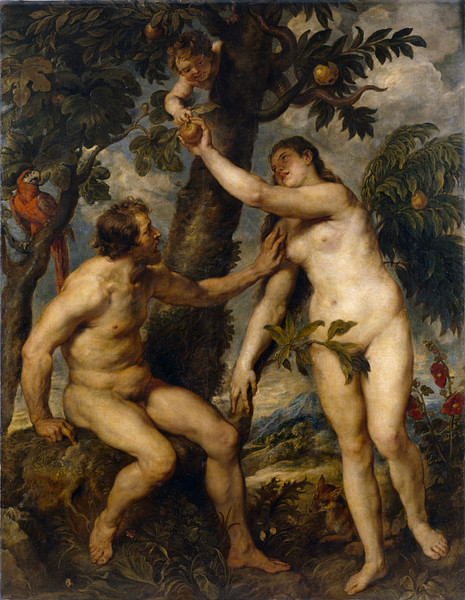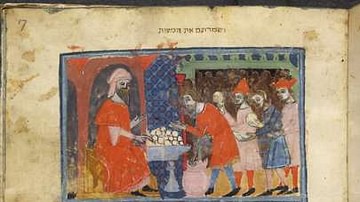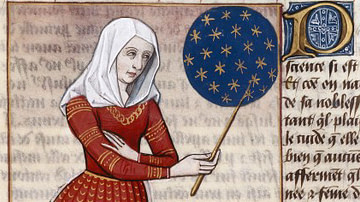
The Garden of Eden is the biblical earthly paradise created by God to be inhabited by his first human creation - Adam and Eve. Some claim that the name “Eden” derives from the Akkadian term edinu, which means 'plain'. In the biblical tradition, the garden is often alluded to by the biblical authors as a luxuriant place, which is why it is sometimes called the “Garden of God.” However, it is the biblical definition of the garden that is our concern here. Adam was the first man created by God in his image. After God saw the loneliness of Adam as "not good," God caused a deep sleep on Adam and created Eve (the first woman) out of Adam's rib as his helper (Genesis 2:20-23). To properly understand what the garden is to the narrator of Genesis, it is important to discern its location, the characters playing roles in it and what took place in it. All these contribute to our understanding of the biblical definition of the “Garden of Eden.”
The Eden narrative is narrated in the Bible's book of Genesis 2:4b-3: 24, which places the garden at the east side of Eden. Commonly, translations have the “Garden of Eden” with the construct element “of,” but the Hebrew text has 'gan-beeden', which is not in the construct form, and that the preposition “be” in 'beeden' is to be translated as “in.” Therefore, it is grammatically incorrect to translate 'gan-beeden' as “Garden of Eden,” but the “Garden in Eden.” The actual location of Eden is disputed amongst scholars, but a number of them have concluded that the garden is an extraterrestrial place – where the gods resided. The water from the garden was the water-source for the two great rivers: Tigris and Euphrates, which are well-known in ancient Mesopotamia for the production of irrigation systems in the surrounding area. Its location then should be placed somewhere in Mesopotamia.
Location & Features
The description of the garden in Genesis 2:10-14 states that the water from Eden watered four important areas: Pishon, which flows into the land of Havilah; Gihon, which flows into the land of Cush; Tigris, which flows into the eastern side of Assyria; and the fourth is Euphrates. The garden is also said to have “every tree that is pleasant to the sight and good for food.” Yet, two trees are singled out: the “Tree of Life” in the middle of the garden and the “Tree of Knowledge of good and evil.” However, the Genesis account is inconsistent at some point, Genesis 2:8-9; 3:1-3 has both trees in the midst of the garden, whereas Genesis 3:22-24 gives the possibility that both trees were planted on the east side of the garden where Adam was originally placed.
Even more, the description of the garden in the Genesis account is not identical with other biblical texts alluding to the garden. For example, in Ezekiel 28, the luxuriant materials found in the garden are not mentioned in Genesis 2:4b-3:24. For some of these reasons, the concept of a “garden” of a god(s) was a very common metaphor in the ancient Near East of where the god(s) resided. For the narrator of Genesis, the “Garden in Eden” was imaginatively constructed for an etiological (origin or cause of things) purpose, not as a divine residence, but of the first man and woman on earth – Adam and Eve. As generally accepted in modern scholarship, Genesis 1-11 is labeled as the “Primeval History,” which includes mythologies and legends that were very common not just in Israel, but throughout the ancient Near East. These myths and legends are not Israelite in origin but were adapted by the biblical writers for either polemical or rhetorical purposes.
Some of the crucial questions readers ought to ask to properly discern the “Garden in Eden” are: What is the purpose of the Eden narrative in the book of Genesis? What did the narrator seek to achieve? Importantly, to reach this goal, readers should not treat the “Garden in Eden” exclusively from the characters playing roles in the narrative, such as God, Adam, Eve, the serpent, the singled out trees: tree of life and the tree of knowledge of good and evil, and especially the narrator's overall purpose. To focus exclusively on the "garden" without acknowledging these characters would only disrupt the plot of the narrative.

ANCIENT INFLUENCE
Employing symbols and metaphors in ancient literature was very common; they contain rhetorical elements in order to persuade readers to accept what has been transmitted. In other words, ancient literature is not aimless. Works provide full expression of something or things. Myths concerning the residence of a god(s) in the ancient Near East are usually in gardens, according to the earliest discovered literature attributed to the Sumerians. In the book of Genesis, instead of God residing in the garden in Eden, God places Adam and Eve in it. This suffices to inform readers the re-adaptation of the garden concept by the narrator of Genesis, which is easily left out by interpreters.
The most celebrated discovered account concerning the garden as a luxuriant place and where gods reside is found in a Sumerian literature called “Enki and Ninhursag”:
The land Dilmun is pure, the land Dilmun is clean;
The land Dilmun is clean, the land Dilmun is most bright…
In Dilmun, the raven utters no cries…
The lion kills not, the wolf snatches not the lamb,
Unknown is the kid-devouring wild-dog…
Its old woman (says) not “I am an old woman,”
Its old man (says) not “I am an old man.”
(in Pritchard, 38)
The Sumerians are considered a highly gifted non-Semitic people of unknown origin who settled in the lower Tigris-Euphrates Valley around the 4th millennium BCE. From the brief description of the idyllic island of Dilmun, it is apparently similar to Christianity's concept of paradise where life never ends. The island or land is described as a “pure,” “clean,” and “bright” and where there is no old age. According to Sumerian literature, this island/land was brought up from earth by the sun-god Utu and turned into a veritable garden of the gods. Apparently, from the garden (Dilmun) in Sumerian myth, it was a place created by god(s) for gods.
THE GENESIS VERSION
The notion of a garden as an extraterrestrial place in Sumerian literature was obviously borrowed by the narrator of the book of Genesis for theological and etiological purposes. To understand Genesis' version of the garden, one must take into consideration the place and characters playing roles in the narrative: God, Garden in Eden, Adam, Eve, the Serpent and the two trees (tree of life and tree of knowledge). The narrator of Genesis clearly refined the Dilmun Island to meet its agenda for his/her/their audience. However, in the Genesis version, the occurrence of death and problems between God and humanity were only pronounced by God as a result of Adam and Eve's deliberate act of eating the fruit from the forbidden 'tree of knowledge'. Apparently, the Garden in Eden, like the land of Dilmun was a place of everlasting joy without death. The securing of the 'tree of life' by God placing the cherubim with a flaming sword in it to prevent access to it was also a result of Adam and Eve's disobedience by seeking to be a god. One other major refinement by the Genesis narrator of the Dilmun Island is that instead of the garden being God's residence, God places Adam and Eve in it. The theological reflection here would be, unlike foreign gods, the God of Genesis is not a selfish god, but a god who sought to establish a relationship with humanity.
Briefly, the purpose of the Eden narrative in the book of Genesis could be interpreted in two ways. First, since the Eden narrative is preceded by the creation story in Genesis 1:1-2:4a that ends with the statement: “And God saw everything that he had made, and behold, it was very good. And there was evening and there was morning, a sixth day,” the Eden story presents a contrasting picture of the completed creation as “very good” with disruption (Adam and Eve's disobedience in Genesis 2:4b-3:24). What readers may easily forget is that God had placed two special trees in the midst of the garden: “Tree of Life” and the “Tree of Knowledge.” More attention has been given to the “Tree of Knowledge” over the “Tree of Life.” The mentioning of the “Tree of Life” has an important function in the narrative as well. God only forbade Adam and Eve from eating a fruit from the “tree of knowledge.” The critical question is, why did God not forbid Adam and Eve to eat from the “tree of life”? God commanded that they are to eat from any tree except for one: the “Tree of Knowledge” (Gen. 2:16-17).
The narrator of the Eden narrative has a motive to reveal that the “tree of life” was also opened to Adam and Eve to eat, however, Adam and Eve, rather, chose to disobey God's command. To the narrator, it is because of Adam and Eve's pride to become gods that evil has entered the world that was created “very good.” For the narrator's intended audience, they must choose life (obedience) rather than death (disobedience). This disobedience led to disruption in God's relationship with humanity because of Adam and Eve. Death or evil (concept) has entered the world that was created “very good” by Adam and Eve, not God. Evil is a human product.
Second, the Eden narrative also functions as an etiological legend seeking to answer questions about human origin. The creation story in Genesis 1:1-2:4a has already confirmed questions concerning the cosmogony, which was God's work. As for the Eden narrative, Adam and Eve were the first humans who were also the first parents who gave birth to humanity. Like cosmogonic literature of the ancient Near East, the Eden legend is designed to speculate on the origins of humanity and its first residence. Apparently, what one finds in the 'Primeval History' section of Genesis are legends about the beginnings of human science, which of course would contradict to 21st century CE scientific discoveries.
CONCLUSION
The Garden in Eden was the first residence of humanity given by God himself. Unlike Sumerian mythologies, the Garden in Eden was created by God not for himself, but for Adam and Eve. The narrator's depiction of God is obviously not a selfish, but a loving God. Genesis apparently elevated God's divine status as not needing a physical residence because it would only disrupt God's omnipresent character. From the above analysis, the Garden in Eden is not the garden “of” Eden but a garden “in” Eden. This presupposes that this particular garden was perhaps not the only garden in Eden based on the Hebrew translation of 'gan-beeden' provided above.








